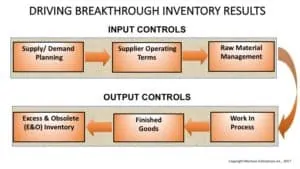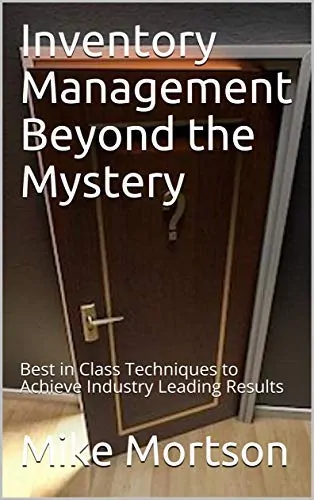Taking a holistic approach in order to achieve Inventory Turnover Breakthrough results meant that I needed to consider the End To End Supply Chain. As I thought through this approach there was really no other way if we were to achieve significant improvements to help the entire business in a short period of time.
In thinking about the End To End Supply Chain it was necessary to define all of the aspects that impact Inventory levels. In short I needed to be able to manage:
- All of the levers that control the rate at which Inventory is brought in to the company
- All of the levers that control the rate at which Inventory moves through the company
- And all of the levers that control the rate at which Inventory moves out of the company
High Level Process Mapping
In detail there are a very large number of these levers which an extensive process map will reveal. I had to translate this thinking into a manageable set of high impact tasks. Thus it was necessary to define a small number of high level levers for which we could assign ownership and targets and drive forward progress.
As such I created this high level End To End Process Chart, It identified the 6 most significant process levers, and teams, that we would launch in order to tackle our Inventory Turnover Breakthrough improvement challenge.


As you consider this approach for your own company and industry you may find that there are different levers that are important to you. For instance if you have the time a tremendous amount of impact on Supply Chain can be captured in the product design cycle. At the other end of the cycle a focus on maintenance and repair parts may be important to you.
For my purpose the 6 main levers I defined here fit best with our business model.
Supply/Demand Planning
The inputs to your SIOP (Sales, Inventory and Operations Planning) process, as well as your MRP system, determine the amount of inventory you plan to order from your suppliers in order to meet that demand. The actual demand that you are required to manufacture or deliver will inevitably vary from the forecasts that drove the procurement of inventory.
Everyone knows that forecasts can be highly inconsistent with actual requirements. A critical Input Control lever was improving the synchronization between Supply Planning and Actual Demand.
Supplier Operating Terms
I have always believed that our Suppliers are our partners. And developing those relationships is critical to business success. Price is obviously a key point of negotiation. However there are many other factors which drive Inventory levels in your company (and with your suppliers). Order lead times, replenishment lead times, minimum order quantities (MOQs), distance between your facilities, supplier/vendor managed inventory (SMI/VMI) agreements, hubs, return privileges, customization points, cycle times, etc are a few.
Given the volatility of Sales/Customer forecasts it is critical to have a flexible, lead time agnostic Supply Chain. This will help to manage the rate at which Inventory comes in to your business.
Raw Material Management
Buying the components and parts you need to run the business is very critical. Especially when there are literally tens of thousands of skus (and their associated parameters), thousands of bills of material, hundreds of suppliers, frequent engineering changes, and fluctuating customer demand. This is a highly complex and fluid environment.
So managing this in the most impactful way required invoking the 80-20 rule. Simply, 80% of the demand, and inventory, was confined to 20% (or less) of the part numbers. We would assign our best and brightest Buyers to micromanage all aspects of the procurement of these “A” Class parts. Thus we would be able to make a rapid dent in our Inventory levels. And we would not compromise our ability to meet customer demands.
Work In Process (WIP)
Depending on your business the majority of the Inventory you have is on warehouse shelves, either as loose components, or as finished goods. However a pacing determinant of how much inventory you could have is your operation. Specifically it is the cycle time required to take raw materials and turn them into finished products. Cycle time constitutes a parameter to be managed for which Lean manufacturing techniques apply.
Another parameter is the order lead time your manufacturing / processing operation may want. Operations wants to have materials staged before manufacturing and processing begins. Just-In-Time production scheduling, Kanban management, and Cycle Time reduction are key focus areas. They will all reduce the time needed to move Inventory through your business.
Finished Goods
You may have customers, depending on your business model, that want you to hold Finished Goods for them. Often customers want to hedge their bets against frequently inaccurate sales forecasts. In addition they want you to hold more Finished Goods then you may deem otherwise necessary.
Focus on increasing the flexibility and speed (in partnership with your Suppliers and Internal Operations) with which your Supply Chain can respond and replenish goods. As a result your customers will see that you can react to their demands while holding less Finished Goods inventory.
Excess and Obsolete Inventory (E&O)
Excess and Obsolete Inventory is one of the least productive uses of your company’s time and assets. There are inaccurate forecasts, engineering changes, product discontinuance, bloated parameters and unnecessary safety stocks. These and many other factors all contribute to the generation of Excess and Obsolete Inventory.
E&O will sit on your shelves consuming cash, gathering dust and incurring extra expenses. This will inevitably result in write-offs which impact your company’s bottom line. Thus working with customers and suppliers to a) disposition your E&O, and b) prevent/reduce the rate of new E&O creation is essential.
Inventory Turnover Breakthrough Begins!
With these 6 key Inventory Control Projects defined the approach required for an all out attack for Inventory Turnover Breakthrough was in place. Each of these projects would require a strong leader. They needed someone who could work at all levels of the organization, and with everyone around the Globe.
Now I had to pick the leadership team. And I had to establish the Inventory Turnover Breakthrough thinking and culture that we would need to make all of this happen!


 EBOOK HERE
EBOOK HERE